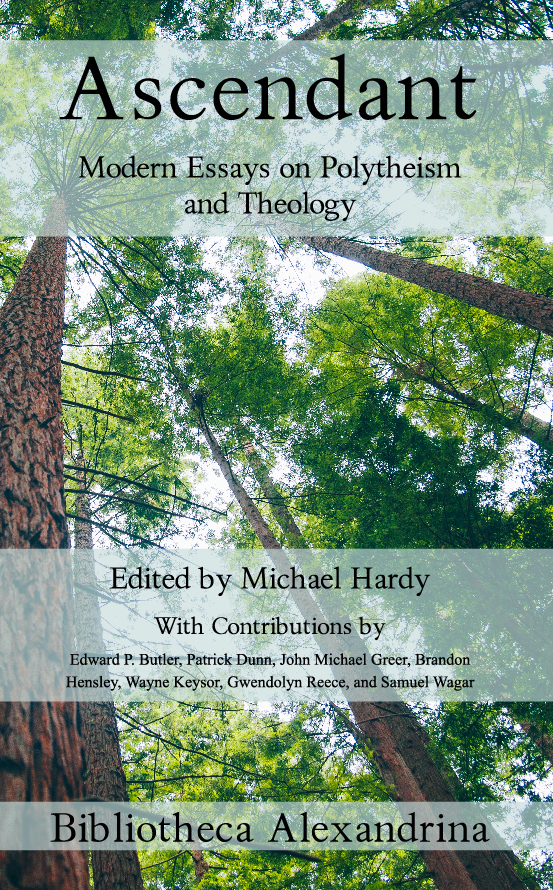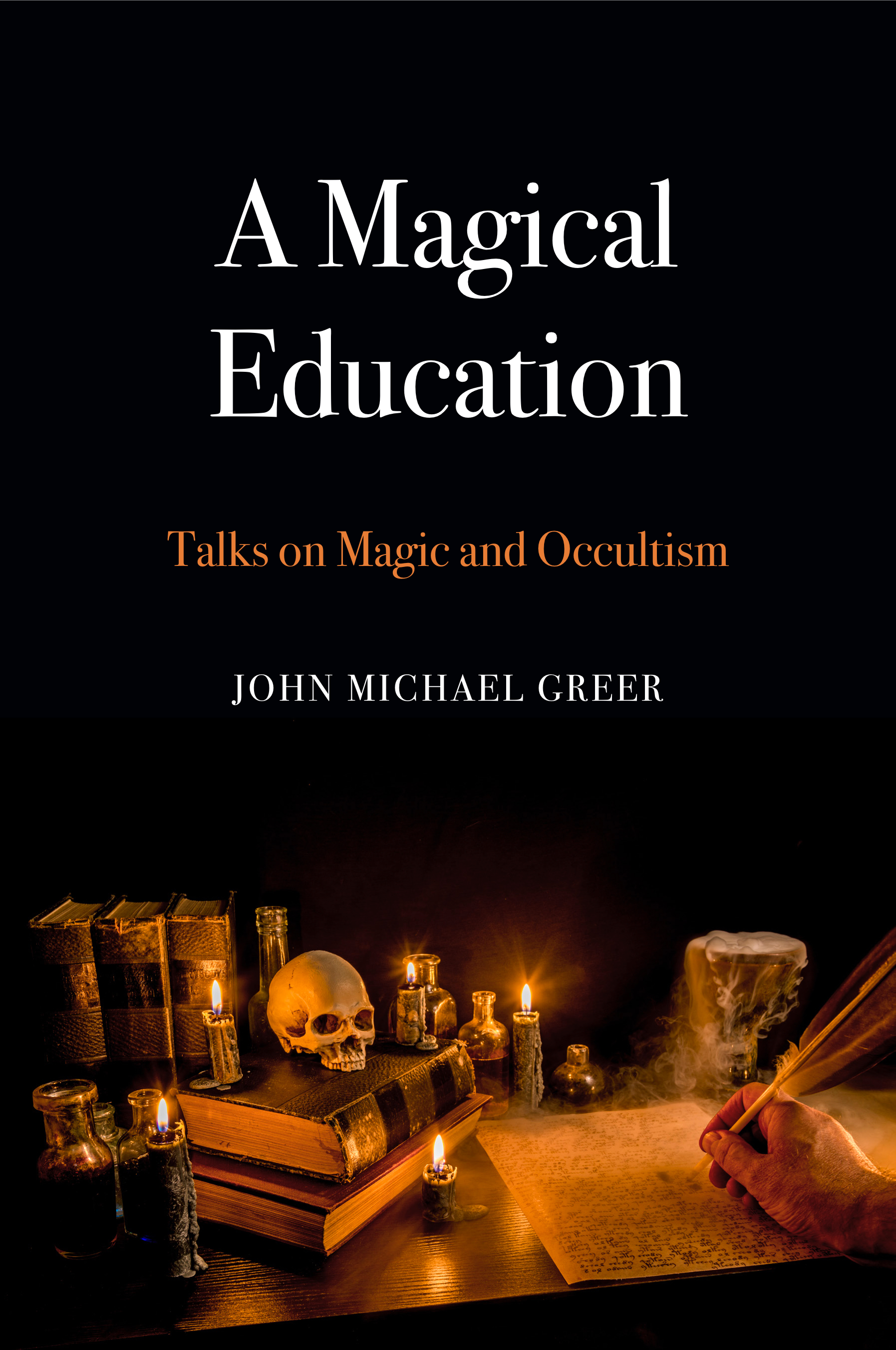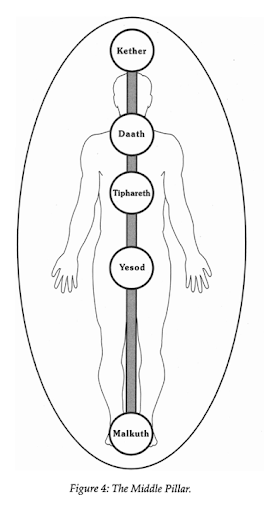
Several previous entries here have covered the basic practices of ceremonial magic in a form reworked for those who follow polytheist faiths. We've discussed
the Lesser Ritual of the Pentagram, which is the most basic ritual working in Golden Dawn-style ceremonial magic, and
the Middle Pillar exercise, which is the basic GD method of spiritual development and inner alchemy. I've heard from a number of people who've been practicing those regularly since then. That being the case, it's time to move on to the next piece of the system: the rituals for opening and closing a temple.
Please note that a magical temple in this sense isn't a building set aside for magical work. I wish I had one of those, but that's kind of hard to afford on a writer's income! A magical temple is a space
temporarily set aside for magical practice. It can be any convenient place. Before the temple is opened and after it's closed, the space can be used for any other purpose. (For example, I use my study as a temple space; the rest of the time, it's where I write.) It needs to be large enough that you can set up an altar in the center and then walk around it without bumping into anything. The altar can be any flat surface at more or less waist height at least 18 inches square -- a folding tray works very well. You can cover it with the altar cloth of your choice, or leave it bare.
You'll also need two pieces of hardware to go on the altar. One of them is something in which you can burn incense; the other is something to hold a small amount of water. These can be as ornate or as simple as you like. I practiced for years with a simple pottery wineglass and a plain wooden incense burner. Put the altar in the middle of the space, with the four sides square to the four points of the compass -- if you have any question where east is, get a magnetic compass and find out. When you stand at the west side of the altar and face east, the vessel of water is on the left side of the altar and the incense burner is on the right.
Once you're set up, you're ready to begin. As with the other polytheist ceremonial magic rituals I've posted here, the marker (PATRON) in the text should be replaced by the name of your own patron deity. Here are the rituals:
Opening the TempleFirst, stand at the west side of the altar, facing east. Raise your right hand, palm forward, to salute the divine powers you will summon during the ritual, and say, “In the name of (PATRON), and in the presence of all the gods and goddesses, I prepare to open this temple.”
Second, perform the complete Lesser Invoking Ritual of the Pentagram to call magical energies into the space.
Third, standing at the west of the altar, facing east, pick up the vessel of water in both hands and raise it up. Say: “Let this temple and all within it be purified with water.” Go to the east, dip the fingers of one hand into the water, and flick droplets of water three times to the east. Go around to the south, and do the same thing; repeat the same action in the west and the north. Return to the east, face east, lift up the vessel of water in both hands, and say: “The temple is purified.” Then go back to the west of the altar and return the vessel of water to its place.
Fourth, standing at the west of the altar facing east, pick up the incense—if you are burning stick incense, just the stick is fine; if you are using cone or loose incense, lift up the burner in both hands. Say, “Let this temple and all within it be consecrated by fire.” Go to the east and with one hand, wave smoke from the incense three times to the east. Go around to the south, and do the same thing; repeat the same action in the west and the north. Return to the east, face east, lift up the incense in both hands, and say: “The temple is consecrated.” Then go back to the west of the altar and return the incense to its place.
Fifth, starting from the west of the altar, walk clockwise in a circle around the altar, passing the east four times. Each time you pass the east, bow your head in respect. This is the ancient and very widespread Pagan rite of circumambulation, still practiced in many polytheist societies around the world. As you walk, imagine your movements creating a whirlpool of energy that draws in magical power from the far reaches of the universe to your magical temple. When you have passed the east four times, circle back to the west of the altar and face east.
Sixth, spread your arms wide and say, “(PATRON), my patron god(dess), I ask you to bless and consecrate this temple of high magic, and aid me with your power in all the work I perform herein.” Pause for a time, and concentrate on sensing your patron deity’s presence and power surrounding you.
Seventh, still standing at the west of the altar facing east, raise your right hand again, palm forward, and say, “In the name of (PATRON), and in the presence of all the gods and goddesses, I proclaim this temple duly open.” This completes the ritual.
Closing the Temple:
First, standing at the west of the altar, facing east, pick up the vessel of water in both hands and raise it up. Say: “Let this temple and all within it be purified with water.” Repeat the process of purifying the temple with water, exactly as you did in the third step of the opening ritual. Then go back to the west of the altar and return the vessel of water to its place.
Second, standing at the west of the altar facing east, pick up the incense and say, “Let this temple and all within it be consecrated by fire.” Repeat the process of consecrating the temple with fire, exactly as you did in the fourth step of the opening riutal. Then go back to the west of the altar and return the incense to its place.
Third, starting from the west of the altar, walk counterclockwise in a circle around the altar, passing the east four times. Each time you pass the east, bow your head in respect. As you walk, imagine your movements dispersing the whirlpool of energy you created earlier and sending the intention of your working out into the universe to accomplish your will. When you have passed the east four times, circle back to the west of the altar and face east.
Fourth, spread your arms wide and say, “ In the name of (PATRON), I set free any spirits who may have been imprisoned by this ceremony. Depart unto your rightful habitations in peace, and peace be between us.” Pause for a moment, and then perform the complete Lesser Banishing Ritual of the Pentagram.
Fifth, standing at the west of the altar facing east, raise your right hand again, palm forward, and say, “In the name of (PATRON), and in the presence of all the gods and goddesses, I proclaim this temple duly closed.” This completes the ritual.
*************************
Okay, now you've got the rituals; what do you do with them?
First of all, of course, you practice them until you can do the complete opening and closing ritual from memory, just as you did with the Lesser Ritual of the Pentagram and the Middle Pillar exercise. (If you haven't practiced those two rituals enough to do them from memory, go back and work on them until you can do that, before you get to work in this ritual.)
Once you've got the opening and closing rituals by heart and can do them with intention, the fun begins. The opening ritual establishes a space in which you can do serious magical practice, and the closing ritual disperses any unused energies and makes the space safe for other purposes. They're the two slices of bread on which you build your magical sandwich. The filling? That's up to you. It can be spellwork, it can be spiritual exercises, it can be active imagination aka scrying in the spirit vision aka Pathworking, it can be whatever kind of magical working you happen to want to get up to. Doing the work in an open temple gives you a safe, cleansed, magically empowered space for any work you want to do, and closing the temple afterwards settles things down afterwards.
There are other ritual elements that get plugged into the ritual structure we're developing here, and we'll get into those as we proceed. For now, try doing this at least once a week; if you don't have anything else to do between the opening and the closing, try doing the Middle Pillar exercise in the space between the opening and the closing.
Have fun, and we'll go further in due time.
 I'm delighted to announce that one of my personal favorites among my books, A World Full of Gods, is back in print in a revised and expanded edition. When it first saw print in 2005, it was literally the Western world's first original work on the philosophy of religion in centuries to take polytheism seriously -- not as a metaphor, not as a mask under which some less challenging set of ideas could be found, but on its own terms, as a live religious option. There have been several other books on the subject published since then, but I think A World Full of Gods still stands up very well among them, and the fan mail I've fielded from Heathens, Kemetics, and many other modern polytheists leads me to think that other people share that opinion.
I'm delighted to announce that one of my personal favorites among my books, A World Full of Gods, is back in print in a revised and expanded edition. When it first saw print in 2005, it was literally the Western world's first original work on the philosophy of religion in centuries to take polytheism seriously -- not as a metaphor, not as a mask under which some less challenging set of ideas could be found, but on its own terms, as a live religious option. There have been several other books on the subject published since then, but I think A World Full of Gods still stands up very well among them, and the fan mail I've fielded from Heathens, Kemetics, and many other modern polytheists leads me to think that other people share that opinion. 
.png) Last week I posted
Last week I posted  In the course of the ongoing conversation over on my blog, the Druid organization Ar nDraiocht Fein (ADF) came up for discussion. Quite a few people mentioned that they had been members of ADF but left the organization, most of them recently -- and one of my longtime readers and students mentioned that he's long been interested in the religious dimension of Druidry and is looking to set up an organization for people who share that interest. That got a lively response from the former ADF members, and the questions that came up immediately were:
In the course of the ongoing conversation over on my blog, the Druid organization Ar nDraiocht Fein (ADF) came up for discussion. Quite a few people mentioned that they had been members of ADF but left the organization, most of them recently -- and one of my longtime readers and students mentioned that he's long been interested in the religious dimension of Druidry and is looking to set up an organization for people who share that interest. That got a lively response from the former ADF members, and the questions that came up immediately were:  I'm delighted to announce that Ascendant II: Theology for Modern Polytheists is now available for sale. Regular readers will recall that Ascendant I came out at the beginning of this year and got an enthusiastic reception from polytheists interested in the intellectual side of their faith; the interest was substantial enough that Neos Alexandria, the group that published the first volume, immediately made plans for another. It apparently didn't take long to get a flurry of first-rate essays -- and so here it is. The essays in this volume are:
I'm delighted to announce that Ascendant II: Theology for Modern Polytheists is now available for sale. Regular readers will recall that Ascendant I came out at the beginning of this year and got an enthusiastic reception from polytheists interested in the intellectual side of their faith; the interest was substantial enough that Neos Alexandria, the group that published the first volume, immediately made plans for another. It apparently didn't take long to get a flurry of first-rate essays -- and so here it is. The essays in this volume are:  Yesterday I fielded an intriguing call for papers, which I've attached below. It didn't come as a complete surprise -- I know the editor -- and I've also heard a fair amount from various corners of the modern polytheist revival about explorations of monastic spirituality. Still, it strikes me as a very good sign. Perhaps the most serious of the many weaknesses of the Neopagan movement is the extent to which it focuses on a purely social, outer-directed model of spirituality; the turn toward a more inner-directed spirituality on the part of contemporary polytheists, I think, is a much needed balancing factor.
Yesterday I fielded an intriguing call for papers, which I've attached below. It didn't come as a complete surprise -- I know the editor -- and I've also heard a fair amount from various corners of the modern polytheist revival about explorations of monastic spirituality. Still, it strikes me as a very good sign. Perhaps the most serious of the many weaknesses of the Neopagan movement is the extent to which it focuses on a purely social, outer-directed model of spirituality; the turn toward a more inner-directed spirituality on the part of contemporary polytheists, I think, is a much needed balancing factor.  I mentioned, a little over a month ago, the imminent release of a new anthology of essays on theology written from a polytheist perspective. It's now available in both print and ebook formats, and
I mentioned, a little over a month ago, the imminent release of a new anthology of essays on theology written from a polytheist perspective. It's now available in both print and ebook formats, and  A Magical Education is the first of three anthologies of my talks and essays, published by Aeon Books. This volume includes nine of the talks I gave at a variety of Pagan and occult conferences between 2001 and 2010 -- specifically, the nine most popular talks, the one I was asked to give again and again. As a taster, here are the titles of the talks:
A Magical Education is the first of three anthologies of my talks and essays, published by Aeon Books. This volume includes nine of the talks I gave at a variety of Pagan and occult conferences between 2001 and 2010 -- specifically, the nine most popular talks, the one I was asked to give again and again. As a taster, here are the titles of the talks:  Several previous entries here have covered the basic practices of ceremonial magic in a form reworked for those who follow polytheist faiths. We've discussed
Several previous entries here have covered the basic practices of ceremonial magic in a form reworked for those who follow polytheist faiths. We've discussed  A while back
A while back  Over the years that I've studied and taught occultism, I've heard from a lot of people who are interested in practicing ceremonial magic but don't find the Jewish or Christian religious context of most ceremonial magic appealing. My book The Celtic Golden Dawn was written in part to set out a system of ceremonial magic for people like me who find the Druid Revival traditions to their taste, but of course there are a lot of people out there who go in different directions. The other day, after a lot of brooding and some questions on the blog along these lines, I got to work, drafted a ritual, and field-tested it to work out the bugs.
Over the years that I've studied and taught occultism, I've heard from a lot of people who are interested in practicing ceremonial magic but don't find the Jewish or Christian religious context of most ceremonial magic appealing. My book The Celtic Golden Dawn was written in part to set out a system of ceremonial magic for people like me who find the Druid Revival traditions to their taste, but of course there are a lot of people out there who go in different directions. The other day, after a lot of brooding and some questions on the blog along these lines, I got to work, drafted a ritual, and field-tested it to work out the bugs.